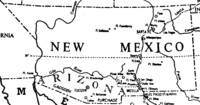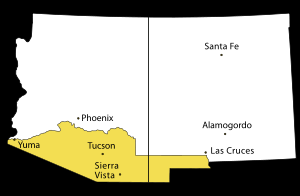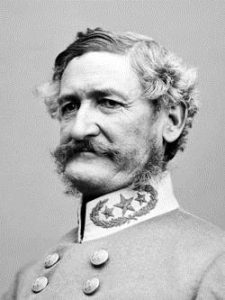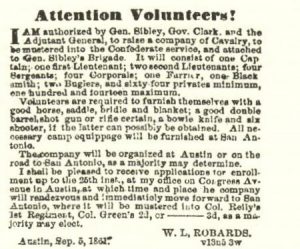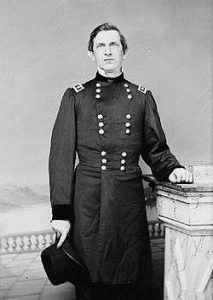The Red River Campaign
THE INVASION OF TEXAS
By
Todd A. Blomerth
(This article is one of a continuing series on various campaigns and battles during the Sesquicentennial Era of the American Civil War)
By 1864, it was becoming increasingly obvious that eventually the Union would prevail against the South. The main question for Lincoln and his generals was how to speed up the demise of the breakaway states. Texas continued as a vital and yet largely untouched part of the Confederacy, providing men, munitions, foodstuffs, and cotton for export. Until this point Texas had avoided most of the ravages of war due to its geographic isolation in the far west of the Confederacy and also thanks to its relatively small population. It wasn’t on the route of any invasion forces, nor had the rebel forces stationed there inflicted much harm to the overall Northern effort. While Texas sent large numbers of men to fight elsewhere for the South, its ability to assist the overall southern war effort with materiel was hamstrung by a northern blockade of the Texas ports on the Gulf of Mexico, and the North’s control of the Mississippi River and the City of New Orleans. However, ways were found to funnel badly needed supplies to the eastern breakaway states, and also to obtain hard cash by the export of cotton (often across the lines to Northern speculators!).
In the third year of the war, following major victories at Vicksburg, Gettysburg, and elsewhere, the North finally had the manpower to consider several additional options to shut down the supply lines from Texas and northern Louisiana to the rest of the South. Lincoln’s General in Chief, Henry Halleck, devised a campaign to seize Shreveport, the capital of Confederate Louisiana ever since the Northern capture of New Orleans in 1862, and seize the vital shipping conduit of the Red River. In the process, the plan called for the destruction of Southern forces in northern Louisiana, capture of thousands of bales of cotton, and finally the organization of a pro-union state government. After solidifying control of Louisiana, Halleck felt that the Union forces could then strike into Texas, and sever the supply lines of goods and armaments flowing out of Tyler and Marshall in East Texas to the remainder of the besieged Confederacy.
Yet some of Lincoln’s top generals feared the invasion would prove a wasteful and time consuming side show to the Union’s primary efforts to defeat the South in the eastern states. Over the strong objections of Grant and Sherman, Halleck instructed General Nathaniel Banks, commander of Union forces in Louisiana, to divert his efforts from supporting Grant’s planned attack on Mobile, Alabama, and Sherman’s planned advance into Georgia. Banks was to send his forces up the sinuous Red River in a two-pronged advance. To support Banks, Halleck ordered troops from Arkansas and recently-captured Vicksburg, Mississippi to move into Louisiana.
The Union plan, such as it was, was for Banks’ ground forces, supported by Admiral David Porter’s ironclads and steamboats to press up the Red River toward Alexandria, and from there toward Shreveport. At the same time, General Frederick Steele was instructed to bring 7000 men southeast from Little Rock, Arkansas, to join forces. General A J Smith’s force of approximately 9000 men, who were to be part of Banks’ main offensive, embarked from Vicksburg, and assembled on Bayou Teche.
The Union forces, including a substantial number of freed African American slaves recruited into the northern army, were the first to encroach into this area where the Confederacy’s supremacy had remained unchallenged. Shreveport was a robust center of mills, foundries, and shipyards. Its shipyards built ironclads meant to challenge the North’s control of the Mississippi. And the North was concerned with the construction of submarines in the shipyards at Shreveport as well. On February 17, 1864, one of these newly invented weapons, the Hunley, sank a Union steamship, the USS Housatonic, off the coast of Charleston, South Carolina. In the attack, the Hunley and all her men were lost as well, but that didn’t remove the Union’s fear that similar weapons would be unleashed on Mississippi river traffic, or other blockaded Southern harbors.
By 1864, several of Texas’ ports were blockaded, and there had been small landings to reinforce the coastal blockades’ effectiveness. The Red River Campaign would strip many troops from that duty. Militarily this was very risky, but political considerations may have played a part in outweighing military strategy. France had invaded and overrun Mexico in 1862 and was sympathetic to the South. The Union was afraid that Mexico would make some pact with the Confederacy. If this happened, at the very least it would make maintain the Southern blockade difficult – and could even expand the scope of the war. Additionally, it was thought that the campaign would (at least in the minds of some) be a fairly easy way to knock Texas out of the Confederacy and thereby close the South’s last foreign outlet on the Mexican border.
In March, Admiral Porter began assembling his fleet at the mouth of the Red River. The rebels were aware of the Union plans and began strengthening Fort DeRussy at Alexandria. However, Union General Smith’s Vicksburg force was able to capture that fort and the town on March 14. Porter’s fleet arrived soon after, hoping to easily steam upriver during the wet season of the year.
However, the Red River had other plans. 1864 was an unusually dry year, and the low water level made river transport difficult. Normally the river was navigable by steamboat traffic as far as Caddo Lake and Jefferson in East Texas, but this year was proving to be different. Porter had ships of varying sizes and tonnage, many of which already had problems moving up from the mouth of the Red. Sandbars and man-made obstacles placed by the rebels made it impossible for Porter’s deeper draft ships to proceed. Falling water levels also threatened the advancing troops’ supply lines if the shallower river boats used to bring provisions could not get upriver. Porter was also skeptical of Banks’ generalship. An outspoken old salt, he had little confidence in Banks as a combat commander, and felt sure that the promise of an easy victory could prove illusory, which would require even more naval support.
As the invasion got off to its shaky beginning, the rebel forces west of the Mississippi were under the overall command of General E. Kirby Smith. After the fall of Vicksburg on July 4, 1863, this vast area became an independent command, so much so that many in the Confederacy nicknamed it “Kirby Smithdom.” Smith placed Major General Richard Taylor (the son of former President Zachary Taylor) in command of the forces that he hoped who suffice to stop the northern invasion. Initially confused as to where the Union forces would strike, Smith and Taylor ordered their men – some of whom had seen little or no action – to be prepared to move at a moment’s notice.
By April 1, Union forces had captured Grand Ecore and Nachitoches and were moving upriver. Taylor’s Confederate forces shadowed the bluecoats, but were not strong enough to challenge them. A desperate call went out for additional forces. Responding to the call to defend Shreveport, several Texas units hurried forward from other posts. Some of these included men from Caldwell County, including Company K of the 17th Texas Volunteer Infantry Regiment and units of DeBray’s 26th Texas Cavalry. As the Union cavalry and infantry moved toward Shreveport, Banks’ forces became stretched out over miles of Northern Louisiana’s primitive roads. The main supply line for the area remained the Red River, and Union ground forces stayed well within range of the covering fire from the flotilla on its right. However, near Mansfield, Louisiana, the driest road in that swampy area curved away from the river – and out of the range of Porter’s fleet. As Banks’ men moved away from the river, the rebels chose to launch an attack, hoping to have enough men in place before Banks could get his forces organized in that vulnerable location. The Southern defenders formed a defensive line at a site called Sabine Crossroads (near the town of Mansfield). Brigadier General Thomas Green arrived soon after with cavalry units to support Taylor, and to also reconnoiter the Union lines.
Also Known as Sabine Crossroads
General Alfred Mouton’s division, made up of Texans and Louisianans, moved in on the Confederate left. “Walker’s Greyhounds,” a Texas division commanded by John G. Walker, and Colonel William G. Vincent’s Louisiana cavalry brigade also helped form the line. Mouton’s men moved forward late in the afternoon of April 8, but the general was soon killed and his men repulsed. But Walker’s Texan’s wrapped around the Union left, flanked it, and broke their line. Panicked Union soldiers broke and ran. Union commanders tried to form a second defensive line. This too was broken, and the rebels pursued the Union forces until a hastily assembled third defensive line. This last line held, and the rebels’ advanced halted.
As Civil War battles went, Mansfield was a small one. Union losses were put at 113 dead, 581 wounded, and 1541 captured. But the Southerners benefited from a huge haul of supplies, horses and mules, and artillery as well as from a big boost in morale following the victory. Taylor decided to press his advantage. On April 9, the advancing rebels met the Union forces again, this time at Pleasant Hill. Pleasant Hill was only a small village of 12 or so huts with a small, bare knoll in the middle of the settlement that gave Banks’ men good defensive positions. Yet lack of fresh water prevented him from holding the area for long.
The rebels began reconnoitering around noon prior to launching their attack. Instead of a single assault against one section of the Union line, the greycoats struck the entire line at once. The Union center and right bowed in, but finally held. A second attack stalled when late arriving Confederate forces, including General Hamilton Bee’s men, and those of DeBray’s Texas Brigade, were ambushed on their way to support the attack. Bee showed incredible courage in rallying his men, and DeBray was seriously wounded. By the time they could extract their units, many of their men had been killed and wounded.
The battle finally ended at 1 a.m. Although Banks called Pleasant Hill a victory, this was an exaggeration. The Confederate advance had been halted, but the rebels still blocked the road toward Shreveport. The Union forces, lacking water, withdrew, and continued their retreat back toward Alexandria. For all intents and purposes, the Red River campaign was over. General lack of confidence in Banks’ competence had by now eroded any chance he had at regrouping and attempting to achieve any of the campaign’s objectives. Taylor wanted Walker’s Texans to assist his forces in hounding the Yankees back toward Alexandria, hoping to rout the withdrawing invaders. Instead, Kirby Smith sent Walker’s division to assist other troops trying to trap Union General Steele’s force, which was still en route from Little Rock. Short of food and supplies, and nearly surrounded at Camden, Arkansas, Steele refused to move any further south after becoming aware of Banks’ failure, and he turned his men around and headed back North. Walker’s men headed the chase but were defeated at the Battle of Jenkins’ Ferry.
Later, Taylor would bitterly claim that Kirby Smith’s failure to provide adequate forces prevented him from striking a death blow to Banks’ and Porter’s forces.
The Red River Campaign had turned into a muddled mess. Banks’ window of opportunity closed permanently when Sherman and Grant required him to release all soldiers detached from Vicksburg no later than May 1.
Porter’s naval forces were now on their own on a river with falling water levels surrounded by rebels. The admiral now focused on saving his ironclads and other ships from destruction or capture.
Next: A grand engineering feat by a Wisconsin logger saves the Union naval forces.

